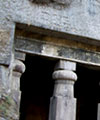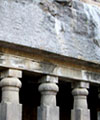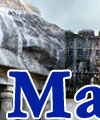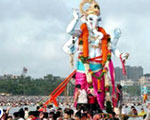| Encyclopedia of Tours and Travel to Maharashtra, featuring information on Fairs & Festivals, Wildlife, Excursion, Adventure and Weather of Maharashtra. |
 |
 |
 |
 |
 |
 |
 |
||
|
Buldhana
[ Lonar | Lonar Crater | Sindkhed Raja | Vishnu temple | Gomukh Temple | Flora and fauna | Khamgaon | Sant Gajanan Maharaj | Worlds Biggest Hanuman Murti ] Lonar Lonar is distinguished by the fact that it is the world's third largest crater. It has its origin nearly 50,000 years ago, when a 2 million-ton meteorite impacted the earth to create a depression 1.83 kilometers in diameter and 150 meters deep. Since that disastrous event, Lonar has evolved into a pleasant expanse of sky blue water among a relaxing emerald forest that stretches around it as far as the eye can see. Today, it attracts casual tourists as well as members of the scientific community from across the world, including research agencies like the Smithsonian Institution of Washington DC, the US Geological Survey, the Geological Society of India, and Sagar University, Jabalpur, and Physical Research Laboratory, Ahmedabad, which have conducted extensive studies about the site. But, the scientific angle aside, this destination also has much to offer wildlife enthusiasts as it is generously endowed in both flora and fauna. The crater is home to hundreds of peafowl, chinkara and gazelles, which browse amongst the shrubs and bushes ringing the lake. Other residents include egrets, moor hens, herons, coots, white-necked storks, lapwings, grey wagtails, grebes, black droungos, green bee-eaters, tailorbirds, magpies and robins - as well as numerous species of migratory birds that often visit the place. Lonar impresses with the richness of its natural heritage. And, like the meteorite that put it on the map, leaves a lasting impression. It is an important place in Buldhana district and is famous for Lonar crater and Lonar Lake. Lonar crater The nearest railway station is Malkapur, on the Mumbai - Bhusawal -Nagpur route of Central Railways of Indian Rail around 100 km from Lonar. Lonar crater in the Buldhana district of Maharashtra state, India is the largest crater in basaltic rock. It is partially filled by a salt-water lake. It is 6,000 ft (1.83 km) in diameter and 170 metres in depth, and its age is estimated to be 52,000 ± 6,000 years. (Pleistocene) Lonar crater is situated around 550 km from Mumbai, 160 km from Aurangabad and 140 km from Buldhana at 19.975° N 76.51° E. It is about 4 1/2 hours drive southeast of the famous Ajanta Caves. The nearest railway station is Jalna on Manmad-Nanded Section of SC Railway. Although once thought to be of volcanic origin, Lonar Crater is now recognized as an impact crater created by the hypervelocity impact of either a comet or meteorite. The impact origin of this crater is clearly demonstrated by the presence of plagioclase that has been either converted into maskelynite or contains planar deformation features (PDFs). Only shock metamorphism caused by a hypervelocity impact could either have transformed plagioclase into maskelynite or created PDFs in it. The impact origin of Lonar Crater is further substantiated by the presence of shatter cones; impact deformation of basalt layers comprising its rim; shocked breccia inside the crater; and a nonvolcanic ejecta blanket surrounding the crater. It has history that dates back more than 50000 years, carved out when a meteor struck it. Lonar Lake, near Lonar village in the Buldhana District, is not just he source of Excitement for the visitors but also for the scientist community. Lonar is the third natural salt-water lake in the world, with a diameter of 1800 meter. It comes after Bosmatvi Lake in Ghana, which has a diameter of 10000 meter and New Cubec in Canada with a Dai of 3500 meter. According to scientists, about 50000 year back a massive meteor entered into the Earth's gravitational forces range. 60 meter long and weighing 20 lac ton it was racing at a speed of 25 kms per second towards the planet. The impact was so severe that it left a massive crater 170-meter deep and with 1800 meter in diameter. Today it is natural salt-water lake. The lake was first brought to notice in 1823 by British officer C J E Alexander. In 1896, American geologist G K Gilbert conducted studies to prove that Lonar was created due to meteor strike. An extensive study conducted on the spot under the leadership of Prof. K Fredrikson by officials of Geological Survey of India, United States Geological survey and other institutions, proved using Cosmic Ray-dating that the lake was created by a meteor hit 50000 years ago. The official dug up the heart of the lake and conducted experiments on the material gathered from there, before making their announcement public. The scientists also found some mineral found mostly in meteor hit areas. Traces of Sodium Carbonate and magnetic properties were also observed in the soil there. Apart form its scientific importance, Lonar also occupies a place of prominence in our ancient scripts. It finds mention in "Aaina-E-Akbari" During the days of Emperor Akbar, a salt factory was located here. According to Sanskrit Literature, Lonar was called "Viraj Kshetra" in ancient times. It finds mention in "Viraj Mahatmya" a chapter in "Skanda Puran and Padma Puran" Sanskrit works. According to Lonar Mahatmya in ancient times, Kashyap Rishi had many sons. One of whom was believed to be staying in the vicinity of Lonar Lake. When Lavanasur terrorized the people and rulers of the region, the son of Rishi Kashyap had prayed to Lord Vishnu to kill Lavanasur. In the 13th Century, a temple of Lord Vishnu as constructed there during the Chalukya Raj. The temple still exists and is 150mt long and 450 mt. wide. IT is a fine example of the quality of architecture practiced and perfected during that era. Near the Lonar Lake is the Paphareshwar pilgrimage. The engravings on the temple located there are in Sanskrit and sadly they have still not been deciphered. The Lonar crater and lake form not only a spectacular sight but over the centuries they have evolved an ecosystem that is not replicated anywhere else in the state. The surface diameter of the crater is 1.80 kms while the crater itself is nearly 132 meters deep. The waters are unique, shifting combination of azure and turquoise and parrot green when seen from the viewpoint. Going down into the crater from the surface is an energetic business as there is no handrails or elevators. There is a local belief that the crater itself is the body of the genius loci, the goddess Lonar Devi and she does not take kindly to construction on her sides. All previous attempts at making a sturdier staircase have been washed away in the rains, and given the intensity of local feeling about it, the authorities have been content with the traditional carved rock path. This is quite steep and is much more difficult to go down than climb up, but the danger is more in overactive imaginations than in anything else. Once down, almost the first sight that greets you is a ruined temple set into a dense forest. This was supposed to be a Rama temple but only the basic structure in stone is left now. There are many temples set round the edge of the lake, all of them constructed in the 12th-13th century in stone but the condition of all of them is not encouraging. What is amazing is the fact that people transported the stone down that steep face and then began to carve and build exactly as they were doing upon the surface at the time. It is an astonishing testament to the energy that would flame forth whenever the cause was a spiritual one. The Vishnu temple and Devi temple are in better condition than the rest but unless you are very determined you will find a full circuit around the lake a tiring business. It can easily take up to three hours, and the temples are scattered all around the rim. It is best to make an early descent, as climbing back up under the midday sun is not the best option. Fortunately, the Maharashtra Tourism Development Corporation has built a tourist complex where all facilities are available. The sensible option is to drive down from Aurangabad the previous evening and make the descent bright and early the next day. That would give you adequate time to see all the temples, observe the detailed carving and architectural styles, as well as fully soak in the forest atmosphere of the crater. For, the crater is host to many species of aquatic birds like flamingos, moorhen, coots, and dabchick and so on. Peacocks are to be seen making spectacular glides from tree to tree. Unlike the rest of the country they do not even need to forage upon the ground; so plentiful is the insect and small prey population in the vegetation. The trees grow to be rather tall and they form a canopy that filters out most of the heat. It does tend to get a bit muggy with the unusual levels of humidity. You can even see dung beetles the size of your palm busily rolling their balls, right in your path. There is no danger of snakes but geckos abound. One feature that has a potential to be a nuisance is the monkey population. They are immensely territorial and throw fruits and twigs at your heads if you have ventured near the trees they stake out. If this is close to running water, as the crater has many little streams with cold water, they become agitated and one monkey actually peed upon me. This was a pretty remarkable achievement as it was up a tree branch at least 50-60 feet off the ground. It is also not a good idea to openly display food, as they will learn soon enough that tourists are easy prey. But, the crater is not the only spot worth seeing in Lonar. A piece of the meteorite had broken off and smashed into the ground about a kilometer away, forming the Ambar Lake. It is a pleasant enough spot but entry is regulated by odd timings so just a look will suffice. Oddly enough the water in this lake is nothing like the main crater. Close by to the Ambar Lake is a nondescript little temple dedicated to Hanuman, the Hindu god of strength and intelligence. What is interesting is that the image of the god is an actual piece of the crater and for long its magnetic properties had fascinated the people who built a temple to house it. The god is supposed to be recumbent, resting after his mighty labors, well known in Indian myth. The meteorite chunk is brightly painted in the orange color that is preferred in this part of the world. The temple itself is a quiet, quaint little spot but it has to be reached through a bedlam of a market place. Once you break through, the landscape is the most flat and open space you will encounter for a while and the temple is set in the middle of this nowhere. The temple is open all day and there is no fuss about taking photographs. It is also mostly deserted all day, which makes it an unlikely area of silence in India. There is a well adjacent to the temple, but the cool water is of dicey quality, so do not let thirst overcome discretion. Where to Stay: MTDC Holiday Resort comprises self-contained rooms and dormitory with a restaurant. Getting there:
Accommodation: Reservation: Sindkhed Raja - Birth Place of Rajmata Jijabai Sindkhed Raja, a small Taluka place in Buldana district, situated 105 kms away from district headquarters Buldhana on the State Highway No. 183, is known world wide as the birth place of Rajmata Jijabai, the mother of the great Maratha Warrior and king, Chhatrapati Shivaji Maharaj. There are a number of monuments in this small township, which owe their existence to Rajmata Jijabai and her father Lakhuji Jadhav. These monuments like Kalkat, Rang Mahal, Tomb of Lakhuji Jadhav, Palace of Lakhuji Jadhav, ancient temple of Neelkantheshwar and Rameshwar have great heritage and architectural value. Getting there:
Vishnu temple Gomukh Temple Getting There
Flora and fauna Khamgaon Khamgaon is the most important cotton ginning market in Buldhana district. MIDC Khamgaon (Khamgaon Industrial Area) is situated 5 km away from the Khamgaon town. Nearby Tourist Places
Shri.Sant Gajanan Maharaj, Shegaon The Samadhi Sthan (Temple) is visited by millions of devotees from far and near. You'll see a large number of pilgrims here, some coming from various parts of Maharashtra, and across the India. Mythological, Shegaon can be described as the Pandharpur of Vidarbha.Thousands of devotees pay their respects at the Samadhi every Thursday, which is regarded as a special day See the temple of Shri Ram, also constructed in the premises of the shrine. If you visit Shegaon on Ram Navami in Chaitra and on Rushi Panchami in Bhadrapada month of the Hindu calendar, you can also attend the fairs held here on these occasions. Getting there: By Railway By Road Worlds Biggest Hanuman Murti, Nandura About Murti: Height: 105 ft. Chest: 70 ft. Base: 30 ft. Tail: 70 ft. Arm: 25 ft. (diameter) Gada 30 ft.Sole 34 ft.Nail of sole:15 ft. Getting there: By Air: Nearest Airport is Aurangabad, 197 kms and Nagpur 317 Kms By Road: One can approach by Road/Bus from Khamgaon a distance of 18 Kms connected with National High Way No.6. Direct Buses of state transport available from major cities of Maharashtra |
|||||||||
|
|||||||||
|
|||||||||
|---|---|---|---|---|---|---|---|---|---|